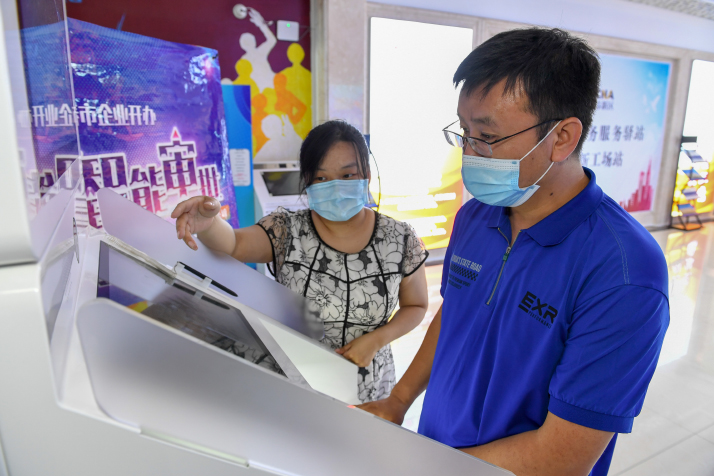|
||||||
|
||||||
| Home Nation World Business Opinion Lifestyle China Focus ChinAfrica Video Multimedia Columnists Documents Special Reports |
|
||||||
|
||||||
| Home Nation World Business Opinion Lifestyle China Focus ChinAfrica Video Multimedia Columnists Documents Special Reports |
| Nation |
| China has made remarkable progress in delivering e-government services |
| By Ji Jing · 2020-07-20 · Source: NO.30 JULY 23, 2020 |
 A resident tells a robot what services he needs at a self-service bank in Shanghai on April 12, 2018 (XINHUA)
Before the introduction of an integrated online-offline one-stop public service system, one had to apply to four government departments to get approval for opening a restaurant in Shanghai. The process took 58 working days and 31 documents needed to be submitted. With the new system, one only needs to hand in 12 documents at one stop and the process takes only 10 working days. The whole process is as simple as shopping online. The recently published UN E-Government Survey 2020 cited the one-stop public service system in Shanghai as an example of successful e-government. The city's e-government portal has over 29.21 million individual users registered with real names and over 2.08 million legal person users. The platform not only allows users to handle a wide range of regular affairs such as business registration and public utility bill payment, but also provides emergency-response information. During the rainy season, preventing flooding in the city is an urgent task. On the platform, there is a real-time map which collects and shares data from 157 water-level monitoring stations, 550 rainfall monitoring points and 26 meteorological data collection stations, along with data from multiple departments' video surveillance using nearly 1,000 cameras. With the help of the data provided by the platform, pump trucks can be stationed in areas that are susceptible to flooding and they can be redirected to areas in need by the command center according to real-time data provided by the platform. The platform also has a role to play in epidemic control. It has a special section dedicated to epidemic control where relevant information is displayed. Higher ranking Shanghai's digital government system is a microcosm of China's e-government progress. According to the UN survey, China's E-Government Development Index (EGDI) increased from 0.6811 in 2018 to 0.7948 in 2020, which is regarded as "very high levels" and its EGDI ranking increased 20 spots to 45th in the world. Its online service index, which is a measure for online government service delivery and a key indicator for e-government development, reached 0.9059, the ninth highest in the world. The survey, published by the United Nations Department of Economic and Social Affairs every other year, is the only global report that assesses the e-government development status of all United Nations Member States. "China's notching up to higher rank is of great significance for improving its national governance ability, enhancing people's sense of fulfillment, and creating a good business environment," Wang Yimin, Director of the E-Governance Research Center, Chinese Academy of Governance, told China Central Television. The progress has been made thanks to the Party and government's emphasis on information technology and digital government. Since the 18th National Congress of the Communist Party of China (CPC), the CPC Central Committee has emphasized the need to promote the modernization of national governance system and capability by developing information technology and building one-stop online service platforms. Online service capabilities have improved. Administrative approval procedures have been streamlined. Many approvals can be given online. With the popularization of smartphones, the government is also providing services via mobile phone applications. In May 2019, the national government service platform was launched, which is connected with 46 State Council departments and 32 local governments. The platform has improved China's overall online government service ability. As of December 2019, the platform had 339 million registered users, which means one out of three Internet users in China had registered on the platform. Local governments across the country are also avidly delivering services via the Internet. Dapeng New Area in Shenzhen, Guangdong Province in south China is using new technologies such as big data and artificial intelligence to improve its online services. The area's government has used big data technology to analyze the needs of visitors to its website. Based on the analysis, it has optimized the website's functions to meet residents' needs. The website's AI-enabled voice input services allow residents to make requests verbally, instead of typing. The government has also launched a service platform on messaging app WeChat. Innovative services are provided on the platform. For instance, there is a "life cycle" section which lists services related to different stages of a person's life such as birth, employment, marriage and retirement. Visitors can choose the stage they are in to find and access relevant public services. The platform also provides residents with information and services related to job recruitment and travel. Jiangxi Province in east China launched a government service app on July 3, which is accessible via mobile payment platform Alipay. The app is supported by big data, cloud computing and block chain technologies to provide enterprises and individuals with convenient services. As of the end of June, the platform's real-name users surpassed 20 million, which means one in every 2.3 people in Jiangxi is using the services. In future, the platform will make use of 5G to launch more online approvals. This year, the novel coronavirus disease epidemic has forced many countries to put cities under lockdown. In the process, Chinese cities have come up with innovative e-solutions in response to the crisis. In Hangzhou, the capital of Zhejiang Province in east China, a city Health Code service has been launched through the government platform based on the health data declared by residents or returned workers and big data collected via various public service platforms. Color codes have been issued to individuals according to the data and the code can be accessed through multiple mobile platforms. People with red and yellow codes needed to be isolated at home, and those with green codes are not restricted in their normal activities.  A business executive (right) submits an application for administrative approval at a self-service terminal in Changchun, capital of Jilin Province in northeast China, on June 16 (XINHUA)
E-government drivers The UN survey shows a continued increase in the uptake of e-government development globally, with 65 percent of UN member states now in the high or very high EGDI group. More than 22 percent of the countries surveyed have moved to a higher EGDI group since 2018. The survey finds that while there tends to be a positive correlation between the EGDI ranking and the income level of a country, financial resources are not the only critical factor in e-government development. Very often, a strong political will, strategic leadership, and the commitment to expanding the provision of digital services will allow a country to achieve a higher EGDI rank than might otherwise be expected. The survey report shows that the reason why China has been able to continuously improve the development level of e-government is that the central and local governments have vigorously implemented the comprehensive digital transformation strategy, said Ma Liang, a professor with the Renmin University of China. In China, e-government development has optimized the business environment, brought convenience to enterprises and people, stimulated market vitality and social creativity, and built a service-oriented government people are satisfied with, the UN report noted. The report also noted particular efforts made by countries to give vulnerable groups access to e-government services. The survey shows that close to 80 percent of UN member states offer specific digital services for youth, women, older people, persons with disabilities, migrants and those in poverty, contributing to efforts aimed at leaving no one behind. The report cited China's efforts in this regard. It said that to "address the needs of persons with disabilities, Beijing has made continuous efforts to improve social security and public services systems by promoting innovative online applications." One of these is a special application that allows persons with disabilities to apply for assistive devices directly from the government website. This process eliminates all certifications and intermediate procedures and enables persons with disabilities to undertake all transactions from home. (Printed Edition Title: Government Services Go Digital) Copyedited by Madhusudan Chaubey Comments to jijing@bjreview.com |
About Us | Contact Us | Advertise with Us | Subscribe
|
||
| Copyright Beijing Review All rights reserved 京ICP备08005356号 京公网安备110102005860号 |